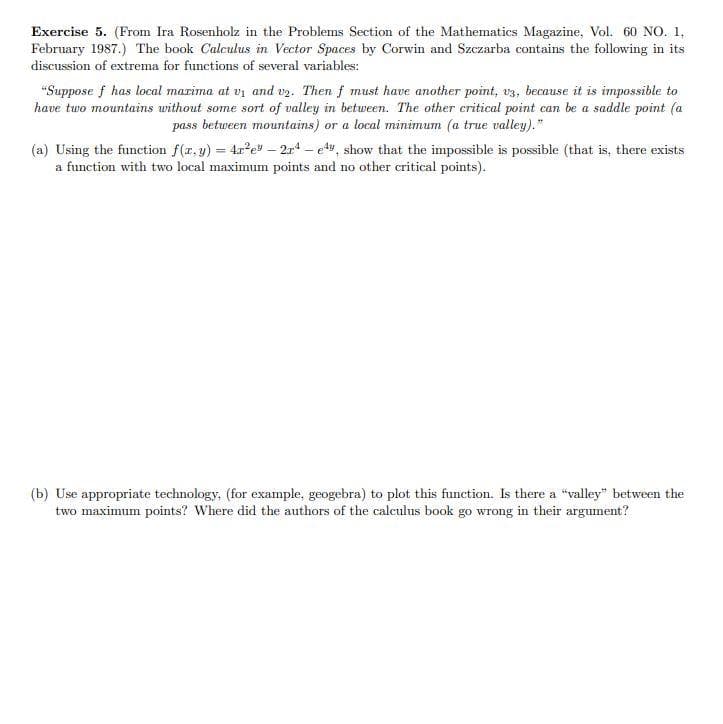Exercise 5. (From Ira Rosenholz in the Problems Section of the Mathematics Magazine, Vol. 60 NO. 1, February 1987.) The book Calculus in Vector Spaces by Corwin and Szczarba contains the following in its discussion of extrema for functions of several variables: "Suppose f has local marima at vi and va. Then f must have another point, v3, because it is impossible to have two mountains without some sort of valley in between. The other critical point can be a saddle point (a pass between mountains) or a local minimum (a true valley)." (a) Using the function f(z, y) = 4r?e" - 2r - etv, show that the impossible is possible (that is, there exists a function with two local maximum points and no other critical points). (b) Use appropriate technology, (for example, geogebra) to plot this function. Is there a "valley" between the two maximum points? Where did the authors of the calculus book go wrong in their argument?
Exercise 5. (From Ira Rosenholz in the Problems Section of the Mathematics Magazine, Vol. 60 NO. 1, February 1987.) The book Calculus in Vector Spaces by Corwin and Szczarba contains the following in its discussion of extrema for functions of several variables: "Suppose f has local marima at vi and va. Then f must have another point, v3, because it is impossible to have two mountains without some sort of valley in between. The other critical point can be a saddle point (a pass between mountains) or a local minimum (a true valley)." (a) Using the function f(z, y) = 4r?e" - 2r - etv, show that the impossible is possible (that is, there exists a function with two local maximum points and no other critical points). (b) Use appropriate technology, (for example, geogebra) to plot this function. Is there a "valley" between the two maximum points? Where did the authors of the calculus book go wrong in their argument?
Linear Algebra: A Modern Introduction
4th Edition
ISBN:9781285463247
Author:David Poole
Publisher:David Poole
Chapter6: Vector Spaces
Section6.2: Linear Independence, Basis, And Dimension
Problem 15EQ
Related questions
Question

Transcribed Image Text:Exercise 5. (From Ira Rosenholz in the Problems Section of the Mathematics Magazine, Vol. 60 NO. 1,
February 1987.) The book Calculus in Vector Spaces by Corwin and Szczarba contains the following in its
discussion of extrema for functions of several variables:
"Suppose f has local marima at vi and v2. Then f must have another point, v3, because it is impossible to
have two mountains without some sort of valley in between. The other critical point can be a saddle point (a
pass between mountains) or a local minimum (a true valley)."
(a) Using the function f(r, y) = 4r?e – 2r - ety, show that the impossible is possible (that is, there exists
a function with two local maximum points and no other critical points).
(b) Use appropriate technology. (for example, geogebra) to plot this function. Is there a "valley" between the
two maximum points? Where did the authors of the calculus book go wrong in their argument?
Expert Solution
This question has been solved!
Explore an expertly crafted, step-by-step solution for a thorough understanding of key concepts.
This is a popular solution!
Trending now
This is a popular solution!
Step by step
Solved in 6 steps with 6 images

Recommended textbooks for you

Linear Algebra: A Modern Introduction
Algebra
ISBN:
9781285463247
Author:
David Poole
Publisher:
Cengage Learning

Elementary Linear Algebra (MindTap Course List)
Algebra
ISBN:
9781305658004
Author:
Ron Larson
Publisher:
Cengage Learning

Algebra & Trigonometry with Analytic Geometry
Algebra
ISBN:
9781133382119
Author:
Swokowski
Publisher:
Cengage

Linear Algebra: A Modern Introduction
Algebra
ISBN:
9781285463247
Author:
David Poole
Publisher:
Cengage Learning

Elementary Linear Algebra (MindTap Course List)
Algebra
ISBN:
9781305658004
Author:
Ron Larson
Publisher:
Cengage Learning

Algebra & Trigonometry with Analytic Geometry
Algebra
ISBN:
9781133382119
Author:
Swokowski
Publisher:
Cengage

Algebra and Trigonometry (MindTap Course List)
Algebra
ISBN:
9781305071742
Author:
James Stewart, Lothar Redlin, Saleem Watson
Publisher:
Cengage Learning